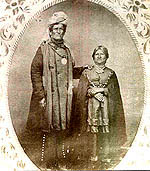Plaque at the site of Hull's landing
Battle of Monguagon

Peshwego and Show-nos-ka-qua
The American government was thinking about declaring war on Britain. They sent
General William Hull to take an army north to Detroit, to be ready for an attack on Canada. Hull's army of 2000 men (mostly militia from Ohio) started towards Detroit in early June.
On June 18, the United States government declared war. Hull had not yet heard definite news of this when he decided to send his personal baggage ahead to Detroit by boat. The British at Amherstburg had received news of the war, so they
captured the Cuyahoga, as it was an American ship. Among the luggage, they found Hull's personal papers, which included the American plans of the war.
Hull and his army arrived in Detroit on July 5, 1812. They invaded Canada a week later. The American army was twice the size of the British detachment, so the British withdrew from Sandwich to Amherstburg. The Americans set up their camp at
François Baby's farm on the river. Hull issued a proclamation that convinced about 500 Canadian militia to desert. The Americans followed the British towards Amherstburg, but were stopped by British troops and Natives at the
River Canard. Hull wanted to have his largest guns with his army when they attacked
Fort Malden at Amherstburg, so he delayed the attack for two weeks until the guns would be ready. On July 29, Hull learned that the British had captured the fur trading post at Fort Mackinac. He started to worry that the northern Natives would come south to help the British. On August 5, a group of Natives under Tecumseh and a company of British troops defeated some Americans on the road outside of Brownstown. The mail to the fort was captured. Another skirmish occurred at the Native village of Maguaga on August 8. General Hull realized that his supply lines had been cut off. He ordered the American troops to withdraw back to Detroit.
|
Plaque at the site of Hull's landing |
Battle of Monguagon |

Peshwego and Show-nos-ka-qua |
See more: General William Hull.
See more: Verchères' account of the capture of the American ship at the beginning of the
war.
See more: Letter from John Askin to a friend, describing the American invasion of Sandwich.
See more: Map of the campaign.
![]()
(See the
transcription)
See more: Skirmishes at the River Canard.
See more: Why Hull did not attack
Amherstburg.
See more: Why Hull withdrew to Detroit.